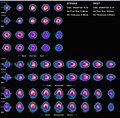Myocardial perfusion imaging
Myocardial Perfusion Imaging (MPI) is a non-invasive imaging test that illustrates how well blood flows through (perfuses) your heart muscle. It can show areas of the heart muscle that aren't getting enough blood flow. This test is often called a nuclear stress test. It can also show the size of the heart chambers, how well they're functioning, and whether there's any damage to them.
Overview[edit]
Myocardial perfusion imaging (MPI) is a form of imaging test that uses a small amount of radioactive substance to detect the health of heart muscle cells and the blood flow to them. This test can be used to diagnose coronary artery disease and other heart conditions.
Procedure[edit]
During the MPI test, a small amount of radioactive substance is injected into the patient's bloodstream. This substance, called a radiotracer, travels through the blood to the heart. A special camera, called a gamma camera, is then used to take pictures of the heart. These pictures can show areas of the heart that may not be receiving enough blood.
Uses[edit]
MPI is used to diagnose and monitor certain heart conditions, such as coronary artery disease, heart attacks, and heart failure. It can also be used to determine how well treatment for these conditions is working.
Risks[edit]
As with any medical procedure, there are some risks associated with MPI. These include allergic reactions to the radiotracer, damage to the veins from the injection, and exposure to radiation. However, the amount of radiation a patient is exposed to during MPI is usually very small.
See also[edit]
References[edit]
<references group="" responsive="1"></references>
-
Myocardial perfusion imaging
Ad. Transform your life with W8MD's Budget GLP-1 injections from $75


W8MD offers a medical weight loss program to lose weight in Philadelphia. Our physician-supervised medical weight loss provides:
- Weight loss injections in NYC (generic and brand names):
- Zepbound / Mounjaro, Wegovy / Ozempic, Saxenda
- Most insurances accepted or discounted self-pay rates. We will obtain insurance prior authorizations if needed.
- Generic GLP1 weight loss injections from $75 for the starting dose.
- Also offer prescription weight loss medications including Phentermine, Qsymia, Diethylpropion, Contrave etc.
NYC weight loss doctor appointmentsNYC weight loss doctor appointments
Start your NYC weight loss journey today at our NYC medical weight loss and Philadelphia medical weight loss clinics.
- Call 718-946-5500 to lose weight in NYC or for medical weight loss in Philadelphia 215-676-2334.
- Tags:NYC medical weight loss, Philadelphia lose weight Zepbound NYC, Budget GLP1 weight loss injections, Wegovy Philadelphia, Wegovy NYC, Philadelphia medical weight loss, Brookly weight loss and Wegovy NYC
|
WikiMD's Wellness Encyclopedia |
| Let Food Be Thy Medicine Medicine Thy Food - Hippocrates |
Medical Disclaimer: WikiMD is not a substitute for professional medical advice. The information on WikiMD is provided as an information resource only, may be incorrect, outdated or misleading, and is not to be used or relied on for any diagnostic or treatment purposes. Please consult your health care provider before making any healthcare decisions or for guidance about a specific medical condition. WikiMD expressly disclaims responsibility, and shall have no liability, for any damages, loss, injury, or liability whatsoever suffered as a result of your reliance on the information contained in this site. By visiting this site you agree to the foregoing terms and conditions, which may from time to time be changed or supplemented by WikiMD. If you do not agree to the foregoing terms and conditions, you should not enter or use this site. See full disclaimer.
Credits:Most images are courtesy of Wikimedia commons, and templates, categories Wikipedia, licensed under CC BY SA or similar.
Translate this page: - East Asian
中文,
日本,
한국어,
South Asian
हिन्दी,
தமிழ்,
తెలుగు,
Urdu,
ಕನ್ನಡ,
Southeast Asian
Indonesian,
Vietnamese,
Thai,
မြန်မာဘာသာ,
বাংলা
European
español,
Deutsch,
français,
Greek,
português do Brasil,
polski,
română,
русский,
Nederlands,
norsk,
svenska,
suomi,
Italian
Middle Eastern & African
عربى,
Turkish,
Persian,
Hebrew,
Afrikaans,
isiZulu,
Kiswahili,
Other
Bulgarian,
Hungarian,
Czech,
Swedish,
മലയാളം,
मराठी,
ਪੰਜਾਬੀ,
ગુજરાતી,
Portuguese,
Ukrainian

